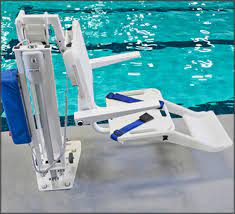Swimming pools are amazing recreational facilities to have fun with, especially in the hot weather. The ADA requires that all pools be effectively compliant; this means they must be readily accessible and usable by people with disabilities. The Americans with Disabilities Act (ADA) was designed to prevent discrimination based on a disability. When a pool is ADA compliant, it means all patrons have equal opportunities to enjoy themselves regardless of their religion, race, or physical disability. Handicapped accessible swimming pools enable people with disabilities to enjoy their leisure time as normal people do. Before you get the answer to the question of “How do I make my pool handicap accessible?”, first get to know what the law requires.
What are ADA accessibility requirements?
To make your pool ADA accessible, you must meet all the below requirements.
Swimming Pool Lifts
The main safety concern with the elderly, injured, or disabled swimmers involve safe entry and exit. Therefore, the ideal solution is a lift. Swimming pool lifts are mechanical devices that are used to provide access to a pool. It can transfer an individual in and out of a swimming pool. Pool lifts can be placed above ground pool or hot tub or on the side of an inground pool. They can be pressure-powered or battery-powered, portable, or fixed, but they give the easiest and most economical way to retrofit a pool for accessibility.
With the lift installed, the disabled can now enjoy the leisure and health benefits of the pool. This is part of the 2010 Standards and regulations of the Accessible Design for Recreational Facilities. All public hot tubs and pools are required to be fitted with an ADA-compliant swimming pool lift.
Sloped Entries
A sloped entry is like a ramp used on dry land. Sloped entries are ideal and primary means of access for facilities with large numbers of ambulatory users. Sloped entries can be built as removable ramps or built-in entryways. They are expensive to build but once installed; they are virtually maintenance-free. Facilities with sloped entries installed are also encouraged to have mobile aquatic chairs designed to provide access to the water. ADA accessible pools must all have sloped entries.
Transfer Walls
Transfer walls or low walls are secondary means of access that allow users to transfer from a wheelchair onto the top of the pool wall and then rotate and pivot easily into the water. According to ADA compliance regulations, a pool must have at least one grab bar that should extend the width of the top of the pool wall. This type of access is common with hot tubs.
Accessible Pool Stairs
Accessible pool stairs are a secondary type of access that provides support and balance to someone entering the pool from a standing position. Accessible come with railings on both sides, which provide support to individuals as they exit and enter the pool. Pool owners who cannot afford to install accessible pool stairs can alternatively install portable access ladders. They often act as an easy-to-use staircase and can be attached anywhere along the edge for easy entry and exit. Accessible pool stairs have a deck adapter platform and slip-resistant tread steps.
The access requirements for each pool depending on the size of the pool. You must have more than 300 linear feet of the pool wall for large pools and two means of access pool stairs. For pools that have less than 300 linear feet of the pool wall, you must provide one, and it must be the primary access.
Transfer systems
This is the combination of accessible stairs and a transfer wall. Transfer systems allow an individual to transfer from a wheelchair to the top of a platform and then go down or up the steps to get out or into the pool. ADA requires that all pools must all working transfer systems.
According to the ADA compliance law, you can have any of the above access ways. You can have a transfer wall, a pool lift, a sloped entry, and stairs or two swimming pool lifts, but you cannot have stairs and a transfer wall.
The legislation only affects local government and state-owned facilities, recreational departments and parks, state-run universities, schools, health clubs, community centers, and private schools. Apartments, private residences, and condominiums are not affected by the law. If you want your pool to be ADA accessible, just ensure all the above-discussed access features are installed on your swimming pool.
In conclusion, it is vital to ensure that all the requirements are met and installed by professionals to rule out accidents. Including people who are physically challenged in such leisure activities is important in their healing process as well as their mental well-being.


